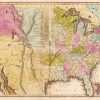calsfoundation@cals.org
El Dorado Female Institute
Beginning operations in the 1840s, the El Dorado Female Institute was the first institution of education for women in Union County. It served members of the community for decades before closing sometime before 1895. The former location of the institute was deeded to the El Dorado Special School District in that year, and the site began housing the administrative offices of South Arkansas College.
What would become the institute dates to 1843, when Presbyterian minister William Lacy and his wife, Julia Lacy, began operating a school associated with their church, which opened the same year. William was a graduate of Hampden-Sydney College in Virginia, and Julia graduated from Miss Lyons Academy in Tennessee and taught school in Pulaski, Tennessee. The original school was reportedly located on North Jefferson Avenue in El Dorado, although other locations are possible.
After two years of running the school from their home, the Lacys sold the business to Elizabeth Banks, the wife of the Reverend Alexander Robinson Banks, a fellow Presbyterian minister. The husband and wife team previously led the Spring Hill Female Academy in Hempstead County and the Minden Female Academy in Louisiana. Elizabeth Banks trained at the Willard Female Institute in Troy, New York.
According to an article published in 1849, the school offered a range of coursework that included typical academic subjects such as spelling, geography, history, astronomy, and chemistry. Additional coursework in French, Greek, and other areas could be had for an additional cost. A music professor offered instruction in guitar and piano for an additional charge and also offered classes to male students. The institute did not have dormitory facilities for the students, who were required to board with families in the community. The board of trustees of the institute included William Rust, the father of U.S. Representative Albert Rust.
Elizabeth Banks died in 1853. The institute continued operations and grew in enrollment. It is unclear who continued to lead daily operations of the institute after the death of Banks. The institute was closely affiliated with the Presbyterian church in El Dorado, although it is not known if it was officially operated by the church. Multiple members of the board were also members of the church and are buried in the Presbyterian Cemetery in El Dorado, including James W. Adams and Hugh Marr.
In 1847, the school received a donation of land from Bennett and Sarah Clark. An additional section of land was sold to the institute on May 7, 1858. This section had originally been obtained as part of a 160-acre Federal Land Patent in 1845, and Albert Rust purchased the property in 1852 for cash and a mortgage on a seventeen-year-old enslaved girl named Alcey. Rust sold five acres of the land to the board of the institute for $250. The contract included a stipulation that the site would continually house the female institute.
The board constructed a two-story building on the site. The eight-room building also included an assembly hall at the rear. It reportedly served as a hospital for Confederate troops during the Civil War.
Details on the operation of the institute after the war are scarce. In 1895, the board sold the land and buildings of the institute to El Dorado Special School District. The district utilized the buildings and began plans for construction of a new facility on the property in 1903. Completed in 1905, the building continues to serve South Arkansas College in the twenty-first century.
For additional information:
Butler, Caitlan. “At Last: SouthArk Re-Dedicates Historic Admin Building in Honor of Charlie Thomas.” El Dorado News-Times, November 21, 2019. https://www.eldoradonews.com/news/2019/nov/21/last-southark-re-dedicates-historic-admin-building/ (accessed August 6, 2025).
“El Dorado Female Institute.” El Dorado Union, September 15, 1849, p. 3.
“El Dorado Junior College Building.” National Register of Historic Places registration form. On file at Arkansas Historic Preservation Program, Little Rock, Arkansas. Online at https://www.arkansasheritage.com/docs/default-source/national-registry/UN0112-pdf (accessed August 6, 2025).
David Sesser
Southeastern Louisiana University





Comments
No comments on this entry yet.